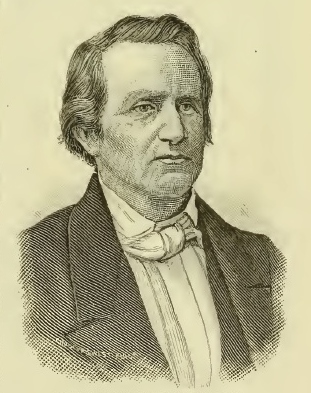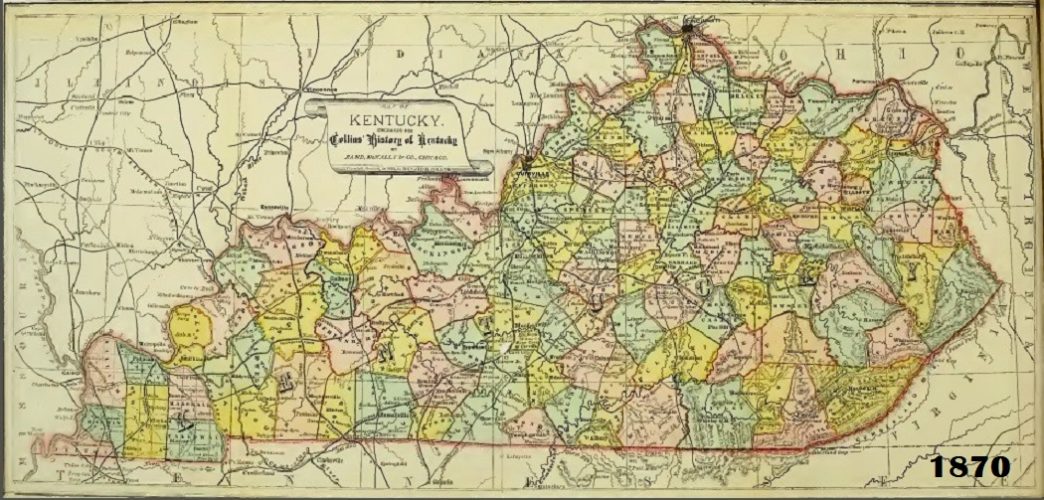 William Lewis was born near Lexington, Kentucky, July 22, 1803, the eighth child of John and Mary Hopkins (Cabell) Breckinridge. He and his brothers Joseph Cabell, John, and Robert Jefferson were joined by a brother named James Monroe in 1806, the same year their father died. William was educated in local academies and professed faith in Christ at the age of 15. He went to college at Transylvania University in Lexington. When the Mt. Horeb Presbyterian Church was organized in 1827 William, his mother Mary, Ann Sophonisba Preston Breckinridge, Mary Clay Smith Breckinridge, and Sophia Rice Harrison constituted the membership. As the only man in the church he was ordained the elder at the age of 24. William’s wife, Frances Prevost, whose mother was a daughter of Samuel Stanhope Smith of Princeton, united with the church two days after its organization. He entered the ministry about 1831 and served his first pastorate in the Presbyterian Church in Maysville until 1833. When his older brother John became secretary of the Board of Education for the Presbyterian Church, he encouraged William to accept a call to the church he was leaving, Second Presbyterian Church, Baltimore, but instead he stayed close to home accepting a professorship at Centre College in Danville.
William Lewis was born near Lexington, Kentucky, July 22, 1803, the eighth child of John and Mary Hopkins (Cabell) Breckinridge. He and his brothers Joseph Cabell, John, and Robert Jefferson were joined by a brother named James Monroe in 1806, the same year their father died. William was educated in local academies and professed faith in Christ at the age of 15. He went to college at Transylvania University in Lexington. When the Mt. Horeb Presbyterian Church was organized in 1827 William, his mother Mary, Ann Sophonisba Preston Breckinridge, Mary Clay Smith Breckinridge, and Sophia Rice Harrison constituted the membership. As the only man in the church he was ordained the elder at the age of 24. William’s wife, Frances Prevost, whose mother was a daughter of Samuel Stanhope Smith of Princeton, united with the church two days after its organization. He entered the ministry about 1831 and served his first pastorate in the Presbyterian Church in Maysville until 1833. When his older brother John became secretary of the Board of Education for the Presbyterian Church, he encouraged William to accept a call to the church he was leaving, Second Presbyterian Church, Baltimore, but instead he stayed close to home accepting a professorship at Centre College in Danville.
From Centre College, William was called to the pastorate of the First Presbyterian Church of Louisville, beginning his tenure the first Lord’s Day of January, 1836, then continuing in service for twenty-three years. During his pastorate the church moved to a lot on the southeast corner of Sixth and Green Streets. The building was dedicated July 21, 1839 in a special service that included visitors from area congregations. Pastor Breckinridge preached on Psalm 48:2, “Beautiful for situation, the joy of the whole earth is Mt. Zion”; the evening service was led by Dr. E. P. Humphrey, of Second Church, Louisville, who delivered his message from 1 Cor. 1:24. In May 1844, the Old School General Assembly met in Breckinridge’s church. Gardiner Spring delivered the opening sermon and George Junkin was elected moderator. W. L. Breckinridge continued to maintain ties to Danville during his Louisville years when he and his brother Robert Jefferson were selected members of the first board of trustees for Danville Seminary in 1853. However, due to health problems, Breckinridge was granted leave of absence for several months to recover, but he continued to have difficulties sufficient to cause him to resign in 1858. After leaving the Louisville church, he supplied two churches in the towns of Midway and Woodford while he considered his next step in ministry.
When the Old School General Assembly convened in the growing city of Indianapolis in 1859, the meeting was called to order by Nathan L. Rice due to the absence of retiring Moderator W. A. Scott of San Francisco. Dr. Rice preached from 2 Cor. 5:7, “We walk by faith, not by sight,” which was not only an appropriate verse for the commissioners in general, but particularly wise counsel for the newly elected moderator, William Breckinridge. The New York Times commented that Breckinridge was
a mild, retiring gentleman, who has, by attending to the peaceful pursuits of pastoral life, gained the respect of all his friends, and the chief honor of the Church which he has served so well and so long.
An issue projected to be controversial for the moderator involved the Boards of the Church, which the Times predicted would set “the debaters of the Court in hot controversy on opposing sides.” One topic that yielded some discussion that the Times had not predicted was the selection of a new location for the New Albany Theological Seminary which at the time was in Indiana. The seminary had struggled throughout its history and the founding of Danville Theological Seminary less than ninety miles away in 1853 had increased its challenges with competition for students. The debate for the new location was between Indianapolis and Chicago, but thanks to a 100,000.00 contribution from farm equipment manufacturer Cyrus McCormick to endow four chairs in Chicago, the windy city became the location of what would be named The Presbyterian Theological Seminary of the Northwest. The Chicago move was further enhanced when a group of benefactors gave 45 acres of land for the campus.
Even though selecting the site for the seminary went fairly smoothly, the choosing of the faculty did not fare so well because when N. L. Rice was running against Dr. MacMaster for one of the faculty chairs a heated debate developed over slavery which included a 2 1/2 hour lecture by MacMaster. It could have been awkward for Breckinridge because he was also a nominee for the chair. In the end, though, MacMaster and Breckinridge lost to Rice. Later in the meeting, Breckinridge was elected by a large margin to fill a vacant chair in Danville Seminary, which was a position he did not accept.
As projected by the Times one of the key decisions with respect to missions was the appointment of a committee to confer with the Board of Domestic Missions and report to the next assembly regarding changes that needed to be made in the organization and methods of the board. The assembly was particularly concerned that the administration should be made as effective as possible to reach the people of the Pacific Coast with missionary efforts. Several considerations for restructuring included moving the Board nearer the center of the western population; establishing several executive committees and corresponding secretaries; or establishing a single central Executive Committee, with Advisory Committees and District Secretaries. Charles Hodge commented in his report of the General Assembly in Biblical Repertory and Princeton Review that, “This report led to a very protracted and interesting debate” (552).
The length of the assembly must have challenged Breckinridge’s stamina because sessions continued for two full weeks excluding Sabbaths from Thursday, May 19, through Thursday, June 2. When the General Assembly convened in Rochester, New York, in 1869, William Breckinridge was not present to convene the sessions and deliver the retiring moderator’s sermon.
W. L. Breckinridge moved in a southern direction in 1860 to become the president of Oakland College in Mississippi. Possibly, turning down the professorship at Danville Seminary was due to his health and he anticipated the warmer climate of Mississippi might relieve some of his difficulties. Oakland College had been opened by the Presbytery of Mississippi in 1830 near the town of Rodney on the Mississippi River. The college continued until it was closed in 1871 and the property was sold to the State of Mississippi to be used for the campus of what became Alcorn State University. Breckinridge was the president of Oakland until he returned to Centre College to serve as its president beginning in October 1863 and continuing until he resigned October 16, 1868.
When he left Centre College, he moved west from Kentucky to live on a farm in Cass County, Missouri, near Kansas. He continued preaching during retirement serving as a minister at large supplying the pulpits of churches too small to call pastors. At some point during his life, he had been honored with a Doctor of Divinity. He died peacefully, December 26, 1876. After the death of his first wife, Frances, he married the widow, Sarah A. Garnett. William’s household had twelve children. Eight of the children reached maturity and all were named according to the honored names of their Cabell and Breckinridge ancestors. James C. Klotter in, The Breckinridges of Kentucky, commented about the life of William that he was
urbane and polished, yet open and unafraid to offer opinions, William Breckinridge, when he died in 1876, ended a life that had presented few opportunities for criticism. (40)
An appropriate eulogy for a faithful minister, churchman, educator, husband, and father.
Barry Waugh
Notes—The header map of Kentucky is from the Collins History of Kentucky, v. 2. The portrait is from Alfred Nevin’s, Encyclopaedia of the Presbyterian Church in the United States of America : Including the Northern and Southern Assemblies, 1884; there are a number of portraits and other images in this book. For a list of Breckinridge’s publications some of which are available for download, see “William Lewis Breckinridge (1803-1876)” on the Log College Press website. E. Warren, The Presbyterian Church in Louisville, Ky., 1816-1896; Catalogue of the Centre College of Kentucky, 1890, Danville: The Kentucky Advocate Printing Company, 1890; New York Times, May 24, and June 3, 1859; James C. Klotter, The Breckinridges of Kentucky, Lexington: University of Kentucky Press, 1986, 2006; Bradley J. Gundlach, “’B’ is for Breckinridge: Benjamin B. Warfield, His Maternal Kin, and Princeton Seminary,” in Gary L. W. Johnson, ed., B. B. Warfield: Essays on His Life and Thought, Phillipsburg: P&R, 2007, 13-53. Per the New York Times, June 1, 1859, the four chairs at McCormick Seminary went to Nathan L. Rice of Chicago, Willis Lord of Brooklyn, Le Roy J. Halsey of Louisville, and William M. Scott of Cincinnati. Other biographies on Presbyterians of the Past that tell about the Breckinridges include, Samuel Miller Breckinridge and Benjamin Breckinridge Warfield.





